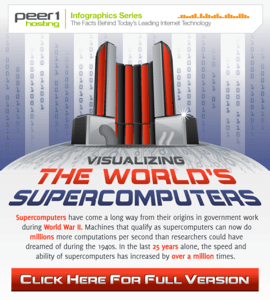The so-called supercomputer is now 70 years old, at least if you have a very expansive definition of supercomputer. The first supercomputer was used for government work during World War II, and was powered by vacuum tubes. Current supercomputers have just a little more oomph, with computing power measured in the petaflops. From the Control Data Corporation 6600 to today’s Top 500, PEER 1 Hostingvisualizes the world’s supercomputers.

The actual numbers are staggering if you consider that, since 1943, the capacity of supercomputers to do work has increased from about 5,000 operations per second to 8.2 petaflops in 2011. The current champion is the K Computer, at the RIKEN Advanced Institute for Computational Science (AICS) from Kobe, Japan. The K comes from the Japanese “Kei,” which represents ten quadrillions – the K’s performance goal is 10 petaflops.
According to PEER 1’s infographic, the progression is expected to continue to the point of one quintillion operations per second in 2020 or so. (It also says that computers are expected to develop self-awareness by 2045, so let me be the first to welcome our coming supercomputer overlords.)
Created by PEER 1 Cloud Hosting

The PEER 1 infographic is pretty interesting, but be sure to skim over the top 500 ranking from June as well. It has some interesting information as well:
- Intel is providing processors for 77.4% of the systems in the Top500.
- Combined performance of the Top500 is 58.88 petaflops.
- The U.S. leads the list with 256 of 500 systems, but that’s down from 274. China is at number two with 62 of the Top500, Germany has 30, the U.K. has 27, and Japan 26.
All of that computing power requires a lot of, well, power. The average consumption of a supercomputer in the top 10 is 4.3 megawatts (MW) of power, and 29 systems on the list use more than 1MW of power. Head over to PEER 1 for the code to share the graphic.










